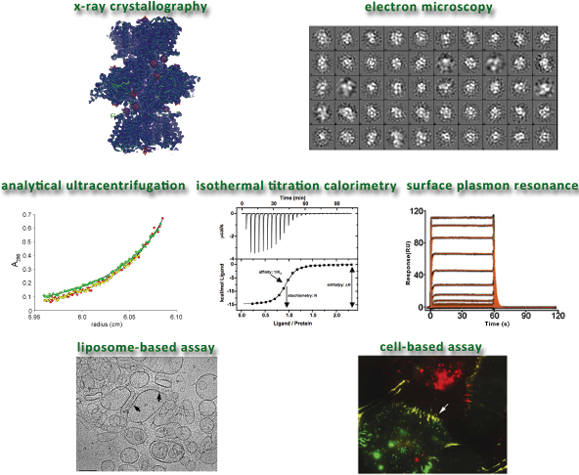Xiangshu Jin

Research
Biological and Physical Chemistry, Structural Biology
(Research Description PDF)
Research in our laboratory aims to understand the molecular underpinnings of biological systems and pathways at multiple levels. We take a multidisciplinary approach combining structural biology (x-ray crystallography, electron microscopy), biochemistry, biophysics (analytical ultracentrifugation, isothermal titration calorimetry, surface plasmon resonance, etc.), chemical biology, cell biology, and computational methods to investigate the mechanisms that underlie fundamental biological processes at atomic, molecular, cellular, and systems levels. Our current research efforts are mainly directed towards the following areas:
Molecular basis of cell-cell communication in development. Formation of multicellular structures with specific biological functions, such as tissues that manifest planar polarity, entails intricate communication networks whereby cells ‘talk’ to each other through specific molecular interactions to coordinate their activities and collectively form elaborate multicellular structures. Planar polarity is a property required for diverse developmental processes that polarizes orientation and behavior of cells across a tissue plane. Defects in planar polarity are associated with a variety of diseases, including cancer, polycystic kidney disease, and neural tube defects. The core components of planar polarity signaling include Celsr adhesion GPCRs, which establish polarized cell-cell junctions across proximaldistal cell boundaries by recruiting distinct molecular complexes to the membrane. Ongoing work in our laboratory aims at gaining structural insights into activation mechanisms of the Celsr adhesion GPCRs with respect to their ectodomain interactions, propagation of conformational changes in the receptor domains across the membrane, and interaction of the receptors with their downstream effectors.
Structural basis for molecular interactions regulating autophagy. Autophagy is an evolutionarily conserved process through which cells degrade and recycle unnecessary components to produce new molecular building blocks. As such, it is essential for cellular and tissue homeostasis as well as cell adaptation or survival under stress conditions. Dysregulation of autophagy is implicated in many pathological situations such as cancer, diabetes, and neurodegenerative diseases. The long-term goal of this line of research is to gain an in-depth understanding of the specifi molecular interactions that drive distinct steps in the process of autophagy. Our current efforts focus on the autophagy factors essential for autophagosome biogenesis and autophagosome-vacuole fusion processes in fission yeast, which will allow us to tease apart species-specific as well as evolutionarily conserved molecular interaction principles that govern autophagy.
Structural basis for molecular interactions regulating necrotic cell death. Cell death is a crucial process during development, homeostasis, and (patho)physiology of multicellular organisms. An imbalance in cell death is linked to many diseases: too much or too sensitive cell death is associated with inflammatory and degenerative diseases, whereas too little or too insensitive cell death can promote cancer and autoimmune diseases. Necrotic cell death is morphologically characterized by cytoplasmic granulation and organelle swelling followed by the loss of cell membrane integrity and release of the cellular contents into the surrounding extracellular space. During regulated necrosis, stimulation of death receptors induces formation of a supramolecular signaling complex termed necrosome, which translocates from cytosol to the plasma and intracellular membranes and forms membrane disrupting pores, thereby executing cell death. Ongoing work in our laboratory aims at elucidating the structural basis for the molecular interactions that underlie membrane disruption in necrosis. By combining biochemical and structural approaches, we seek to characterize the protein-protein and protein-lipid interactions required for necrotic membrane disruption; obtain structural models for the membrane disruptive molecular machineries; and validate our models using quantitative liposome and cell-based functional assays.

Contact / Webpage
Area(s) of Interest
Biological (Bi)
Analytical (An)
Physical (Ph)
Selected Publications
Gating of the TrkH ion channel by its asso- ciated RCK protein, TrkA, Cao, Y.; Pan, Y; Huang, H; Jin, X; Levin, E.J.; Kloss, B.; Zhou, M., Nature 2013, 496(7445), 317-322.
Crystal structures of Drosophila N-cadherin ectodomain regions reveal a widely used class of Ca2+-free interdomain linkers, Jin, X.; Walker, M.A.; Felsovalyi, K.; Vendome, J.; Bahna, F.; Mannepalli, S.; Cosmanescu, F.; Ahlsen, G.; Honig, B.; Shaprio, L., Proc. Natl. Acad. Sci. U.S.A. 2012, 109(3), E127-134.
Crystal structure of a phosphorylation-cou- pled saccharide transporter, Cao, Y.; Jin, X.; Levin, E.J.; Huang, H.; Zong, Y.; Quick, M.; Weng, J.; Pan, Y.; Love, J.; Punta, M.; Rost, B.; Hendrickson, W.A.; Javitch, J.A.; Zhou, M., Nature 2011, 473(7345), 50-54.
Crystal structure of a potassium ion trans- porter TrkH, Cao, Y.; Jin, X.; Huang, H.; Derebe, M.G.; Levin, E.J.; Kabaleeswaran, V.; Pan, Y.; Punta, M.; Love, J.; Weng, J.; Quick, M.; Ye, S.; Kloss, B.; Bruni, R.; Martinez- Hackert, E.; Hendrickson, W.A.; Rost, B.; Javitch, J.A.; Rajashankar, K.R.; Jiang. Y.; Zhou, M., Nature 2011, 471(7338), 336-340.
Splice form dependence of beta-neurexin/ neuroligin binding interactions, Koehnke, J.; Katsamba, P.S.; Ahlsen, G.; Bahna, F.; Vendome, J.; Honig, B.; Shapiro, L.; Jin, X.,Neuron 2010, 67(1), 61-74.
Crystal structure of the extracellular cho- linesterase-like domain from neuroligin-2, Koehnke, J.; Jin, X.; Budreck, E.C.; Posy, S.; Scheiffele, P.; Honig, B.; Shapiro, L., Proc. Natl. Acad. Sci. U.S.A. 2008, 105(6), 1873-1878.
The ankyrin repeats of TRPV1 bind multiple ligands and modulate channel sensitivity. Lishko, P.V.; Procko, E.; Jin, X.; Phelps, C.B.; Gaudet, R., Neuron 2007, 54(6), 905-918.
Crystal structure of potato tuber ADP- glucose pyrophosphorylase, Jin, X.; Ballicora, M.A.; Preiss, J.; Geiger, J.H., EMBO Journal 2005, 24(4), 694-704.
CV
B.S., 1995, Peking Univ., China;
Ph.D., 2002, Michigan State Univ.;
Postdoctoral Research Associate, 2003, Michigan State Univ.;
Postdoctoral Research Fellow, 2003-06, Harvard Univ.;
Associate Research Scientist, 2006-12, Columbia Univ.;
Assistant Investigator, 2012-15, National Institute of Biological Sciences, Beijing, China.